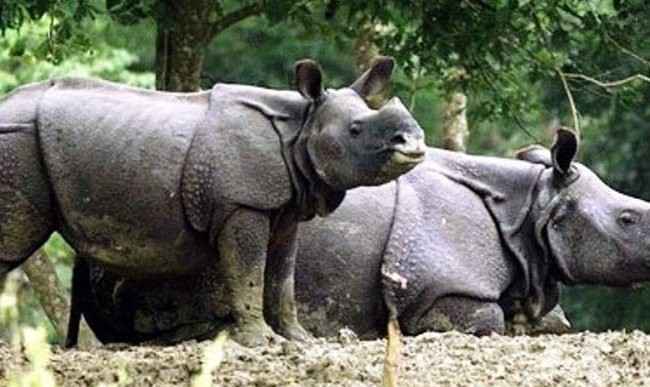No end to mysterious deaths of rhinos

By Basanta Parajuli
Chitwan, Feb. 3: Chitwan National Park has been able to protect rhinoceros from poachers but with three rhinoceros dying from unknown causes in a five-day period, it has been a topic of major concern among conservationists. While a rhino was found dead on Saturday, two others were found dead on Tuesday.
According to park officials, the rhino which died on Saturday at Seheri area of East Nawalparasi was sick for some time.
With no exact cause revealed of the death, the rhinos have been suspected of dying due to consumption of poisonous food by experts and Chitwan National Park (CNP) officials.
“We have not been able to identify the cause of the death. However, we suspect they died after consuming poison, which farmers keep in their crops to protect them from wildlife,” said Bed Bahadur Khadka, interim chief conservation officer of CNP.
Since it is a time when there is less grass inside the CNP, rhinos have been entering human settlements in search of food.
“We are not sure if our suspicion is correct. However, we are conducting research to dig out the concrete reason behind the unknown cause of the death of rhinos,” added Khadka.
In March 2015, an 18-year-old female rhino was diagnosed with tuberculosis in CNP. After the incident, tuberculosis was diagnosed in 11 other elephants. The five elephants, which died in the last one and a half year period, were among the 11 elephants diagnosed with tuberculosis earlier.
“The number of deaths of rhinos is higher nowadays than when poaching was rampant,” said Kamal Jung Kunwar, former chief conservation officer of the park.
A total of 14 rhinoceros, including the recent three, have died at CNP in the current fiscal year. In the previous fiscal year 2018-19, the CNP had registered 43 rhinoceros death. Similarly, 26 rhinos died in 2017-18 and 25 in 2016-17. “While poaching was rampant, we focused to control it. Now, the reason of wildlife death is different and unknown. The reason should be found out,” said Kunwar, who is also the author of the book ‘Four Years for the Rhino’.
Experts have also suspected increase of miconia grass, an invasive poisonous plant, in CNP as a reason behind the unknown deaths of rhinos.
“Not only rhinos but even elephants are dying and the reason is unknown. If the cause
cannot be identified in Nepal, the organs and specimens can be sent abroad,”
said Dr Kamal Gaire, a retired
veterinarian of CNP.
According to the 2015 count, Chitwan National Park (CNP) is a home to 605 rhinos out of 645 rhinos found in Nepal. As per the count, there were 29 rhinos in Bardia National Park, eight in Shuklaphanta National Park and three in Parsa National Park.
“If the national park and concerned authorities do not take the situation seriously and aim to find the unknown reason behind the death of rhinos, the endangered species falls under serious danger,” said Ram Prit Yadav, former chief conservation officer of CNP.
Recent News

Do not make expressions casting dout on election: EC
14 Apr, 2022
CM Bhatta says may New Year 2079 BS inspire positive thinking
14 Apr, 2022
Three new cases, 44 recoveries in 24 hours
14 Apr, 2022
689 climbers of 84 teams so far acquire permits for climbing various peaks this spring season
14 Apr, 2022
How the rising cost of living crisis is impacting Nepal
14 Apr, 2022
US military confirms an interstellar meteor collided with Earth
14 Apr, 2022
Valneva Covid vaccine approved for use in UK
14 Apr, 2022
Chair Prachanda highlights need of unity among Maoist, Communist forces
14 Apr, 2022
Ranbir Kapoor and Alia Bhatt: Bollywood toasts star couple on wedding
14 Apr, 2022
President Bhandari confers decorations (Photo Feature)
14 Apr, 2022











